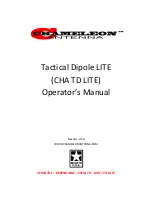
CHA TD LITE
Page 10
Figure 4. Sloping Wire Configuration.
Connect the Matching Transformer. Refer to figure
(2) for steps (3)
–
(9).
3.
Connect the Carabiner from the Wire Connector
end of an Antenna Wire to the Transformer
Eyebolt (j).
4.
Connect the Wire Connector from the Antenna
Wire to the Bottom Transformer Connection (i).
Tighten the wing nut finger tight.
This is the
counterpoise for this configuration.
5.
Using a Bowline of similar knot, tie one end of
short length (around four feet) of Paracord to
the Carabiner connected in step (3).
6.
Connect the Carabiner from the Wire Connector
end of the other Antenna Wire to the Carabiner
from step (3).
7.
Connect the Wire Connector from the Antenna
Wire to the Top Transformer Connection (h).
Tighten the wing nut finger tight.
8.
Using a Bowline or similar knot, tie a long length
(around 50 feet) of Paracord to the Isolation
Loop (c) at the free end of the Antenna Wire.
9.
Connect the UHF Plug from the Coaxial Cable to
the UHF Socket (g) on the Matching
Transformer.
Raise the Antenna.
10.
Using a throw weight or some other method,
loop the long length of Paracord over the
support.
11.
Raise the end of the Sloping Wire antenna to the
desired height and secure the Paracord to the
support using a Round Turn and two Half
Hitches or similar knot.
Extend the Antenna Wire and Counterpoise Wire.
12.
Fully extend the Antenna Wire.
13.
Drive a Stake around two feet beyond the end
of the Antenna Wire.
14.
Using two Half Hitches, tie the short length of
Paracord from the Matching Transformer to the
Stake, such that the Antenna Wire is not quite
taut.
15.
Extend the counterpoise Antenna Wire along
the ground in any convenient direction.
16.
Perform operational test.
Inverted
“
L
”
The CHA TD LITE Inverted
“L” configuration, see figure (5
), is a broadband short to medium range HF antenna for
frequencies below 12 MHz. This configuration is tends to be unidirectional, favoring the end of the horizontal part
of antenna. It is also provides effective ground waves communication during the day time on frequencies between
1.8
–
4.0 MHz without using sky wave propagation. The
Inverted “L”
requires two supports and is suitable for




































